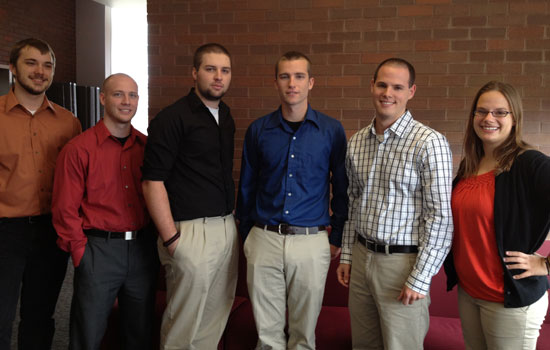Engineering projects recognized at conference
Three teams of RIT students invited to ASME 2013 Summer Bioengineering Conference
The un-tethered mechanical ankle-foot orthotic team is one of six finalists at the ASME 2013 Summer Bioengineering Conference, and one of three teams from RIT to attend the conference. The team members are, from left: Dana Kjolner, Robert Ellsworth, John Williams, Sam Hosig, Shane Reardon and Patricia Schiotis.
Three senior design teams from the Kate Gleason College of Engineering will be attending the American Society of Mechanical Engineering 2013 Summer Bioengineering Conference on June 26-29, in Sunriver, Ore.
One of the teams, which designed an active ankle-foot orthotic, is one of six finalists in the Undergraduate Design Project Competition in Rehabilitation and Assistive Devices at the conference. The active orthotic is designed to assist people who suffer from foot-drop and utilizes a terrain sensing system, developed by graduate student Christopher Sullivan, to determine when to reposition the user’s foot angle to accommodate for uneven terrain. The team will receive an award of $3,000 for travel expenses. The other two RIT teams were selected to participate in a poster session and will have their papers published in the conference proceedings.
As a competition finalist, the active ankle-foot orthotic team will give a 15-minute presentation during a podium session in front of a panel of judges. They will be scored on a variety of criteria, including product need and market potential, performance of the device and presentation clarity and style.
Elizabeth DeBartolo, an associate professor in the mechanical engineering department at RIT, oversaw two of the teams, while she and Kate Leipold, an instructor in the mechanical engineering department, jointly oversaw the third. DeBartolo specializes in the research and development of rehabilitation aids and assistive devices, and she frequently leads her senior design teams in these fields, thanks to an ongoing grant from the National Science Foundation. She says that getting her students to submit their work to conferences is an important aspect of the projects.
“Our senior project students are doing great work and it’s nice for them to get this kind of recognition,” says DeBartolo. “The opportunity to publish that work is important for the students’ own professional development, and their success in the ASME competition is an indication that their projects are really among the best in the nation in the field of assistive technology.”
All three RIT teams involved students from multiple engineering disciplines, including industrial, mechanical, computer and electrical. The two other projects were a jib trimmer transfer bench, which allows a person with limited mobility to be able to fully perform the tasks of a jib trimmer in a sailboat, and an air muscle actuated ankle-foot orthotic, which also aids people with foot drop.
“The uniqueness of the system, which is able to detect the upcoming terrain and adjust the foot accordingly, has high market potential and is one of the aspects of our project that helped in our selection to the conference,” says Patricia Schiotis, who served as manager of the active ankle-foot orthotic team. Schiotis graduated from RIT this past winter quarter with a degree in mechanical engineering.
“Being selected as a finalist reflects the hard work and time put in by each group member for the completion of the project,” she says.















